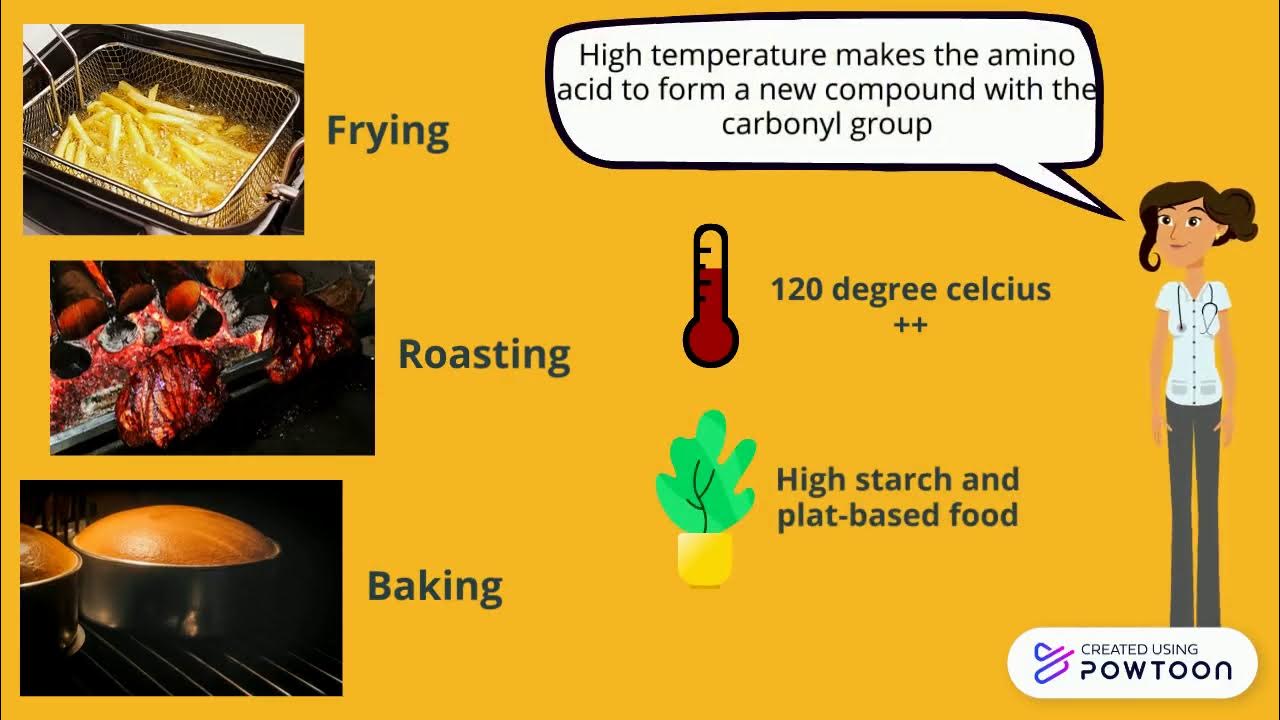Browning Reactions in Foods Animation
Summary
TLDRThis video discusses how chemical reactions influence the food we eat, highlighting two key browning processes: enzymatic and non-enzymatic browning. Enzymatic browning, often undesirable, causes discoloration in cut or bruised fruits and vegetables. Non-enzymatic browning, including the Maillard reaction and caramelization, produces desirable flavors and colors in foods like steak, bread, and caramel. The Maillard reaction involves reducing sugars and proteins, while caramelization involves heating sugars. Both reactions contribute to the taste, color, and texture of many baked goods and savory foods.
Takeaways
- 🍎 Browning reactions play a key role in affecting the desirability of foods, with some reactions causing undesirable effects while others enhance flavor and aroma.
- 🔬 Enzymatic browning is responsible for the discoloration in fresh-cut fruits and vegetables when phenolic substrates react with polyphenol oxidase enzymes in the presence of oxygen.
- ❌ Enzymatic browning is generally seen as undesirable and occurs when fruits and vegetables are bruised or cut, allowing enzymes and substrates to come into contact.
- 🍞 Non-enzymatic browning, on the other hand, is responsible for pleasant aromas and flavors in many foods, with the Maillard reaction and caramelization being the two main types.
- 🍖 The Maillard reaction occurs when a reducing sugar reacts with an amino group, forming glycosyl amine and leading to the development of meaty flavors and brown coloring in cooked foods.
- 🍬 Caramelization involves heating sugar above its melting point, causing dehydration, decomposition, and polymerization to create caramel-colored compounds.
- 🥖 Baked goods, such as bread and cookies, display both the Maillard reaction and caramelization, contributing to their golden-brown crust and rich flavor.
- 🔥 The Maillard reaction can occur at lower temperatures but is much faster when heat is applied, playing a key role in foods like steak and toast.
- 🍫 Caramelization provides the rich flavor and color in foods like caramel, marshmallows, and peanut brittle, with longer heating resulting in darker, less sweet flavors.
- 🌾 Non-enzymatic browning reactions help baked products retain moisture and extend their freshness, making them not just flavorful but also more durable.
Q & A
What are the two major types of browning reactions mentioned in the script?
-The two major types of browning reactions are enzymatic browning and non-enzymatic browning.
What causes enzymatic browning in fresh-cut fruits and vegetables?
-Enzymatic browning occurs when the phenolic substrates and polyphenol oxidase enzymes in fruits or vegetables come into contact after being cut or bruised, leading to a reaction in the presence of oxygen, which produces undesirable brown compounds.
What is the Maillard reaction and how does it start?
-The Maillard reaction is a type of non-enzymatic browning that starts with a reaction between the carbonyl group of a reducing sugar (like glucose) and a free amino group from an amino acid or protein, producing glycosyl amine. This reaction is key in developing flavors and colors in food.
What foods commonly undergo the Maillard reaction?
-The Maillard reaction is responsible for the flavors and colors in foods like cooked steak, caramel, toast, beer, chocolate, coffee, and maple syrup.
How does sucrose participate in the Maillard reaction?
-Although sucrose is a non-reducing sugar, it can hydrolyze into glucose and fructose under high temperatures and low pH, and these reducing sugars can then participate in the Maillard reaction.
What role does heat play in the Maillard reaction?
-Heat accelerates the Maillard reaction, although the reaction can still occur at lower temperatures, but at a much slower rate.
What are the two types of non-enzymatic browning reactions?
-The two types of non-enzymatic browning reactions are the Maillard reaction and caramelization.
How does caramelization differ from the Maillard reaction?
-Caramelization involves the heating of sugar (such as sucrose) to a high temperature, causing it to dehydrate, decompose, and polymerize to form caramel-colored compounds. Unlike the Maillard reaction, caramelization does not involve amino groups.
What is an example of caramelization in cooking?
-An example of caramelization is making caramel glaze by heating sucrose in a pan with water. Other examples include toasted marshmallows and peanut brittle.
What type of browning reactions occur in baked products?
-Baked products, such as breads, cakes, and cookies, experience both the Maillard reaction and caramelization, resulting in the golden-brown crust, desirable flavor, and moisture retention.
Outlines

Cette section est réservée aux utilisateurs payants. Améliorez votre compte pour accéder à cette section.
Améliorer maintenantMindmap

Cette section est réservée aux utilisateurs payants. Améliorez votre compte pour accéder à cette section.
Améliorer maintenantKeywords

Cette section est réservée aux utilisateurs payants. Améliorez votre compte pour accéder à cette section.
Améliorer maintenantHighlights

Cette section est réservée aux utilisateurs payants. Améliorez votre compte pour accéder à cette section.
Améliorer maintenantTranscripts

Cette section est réservée aux utilisateurs payants. Améliorez votre compte pour accéder à cette section.
Améliorer maintenant5.0 / 5 (0 votes)






